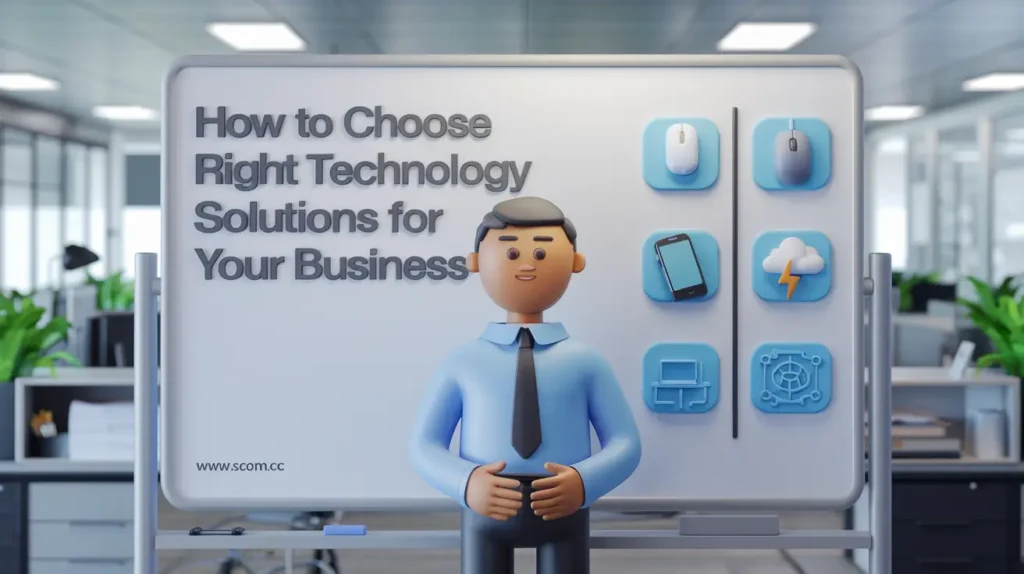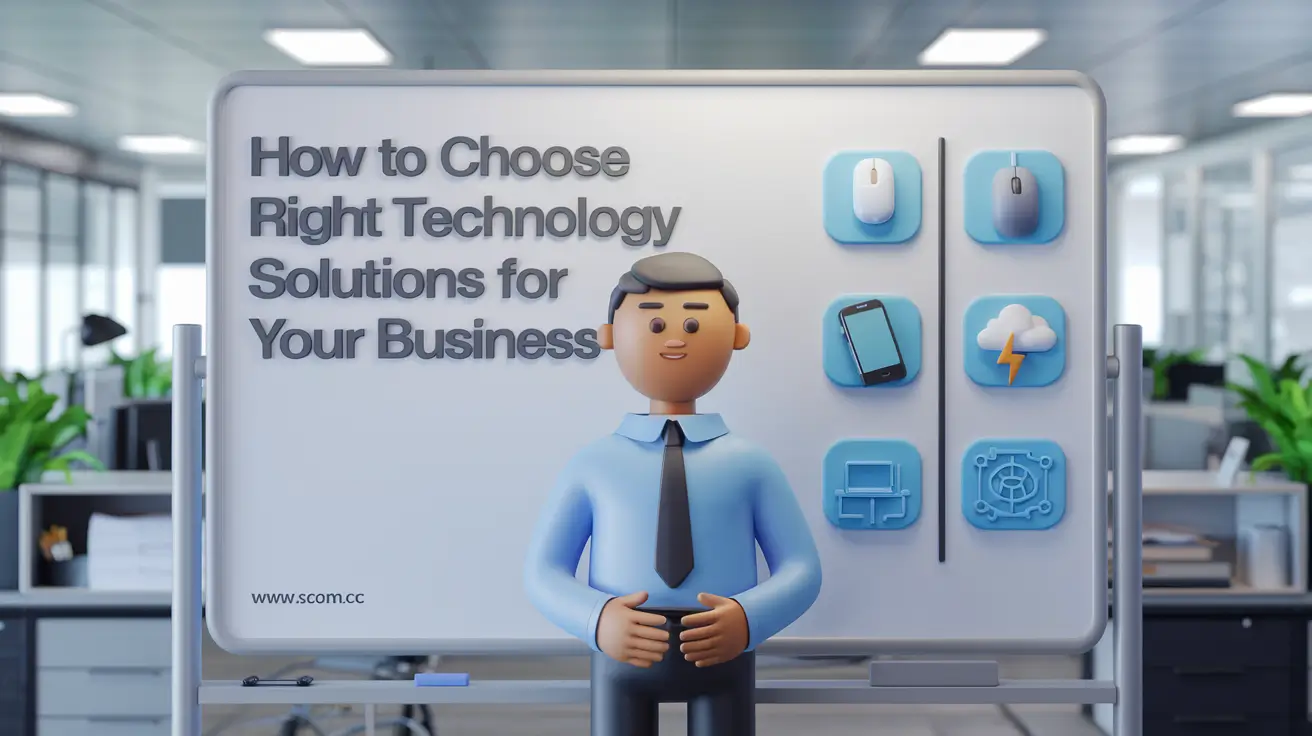How to Choose the Right Technology Solutions for Your Business

- How to Choose the Right Technology Solutions for Your Business
- Understand Your Business Needs
- Research Available Technology Solutions
- Evaluate Cost and Return on Investment (ROI)
- Ensure Compatibility and Integration
- Evaluate Vendor Support and Services
- Plan for Implementation
- Monitor and Evaluate Post-Implementation
- Summary Table
-
FAQ
- How do I determine what technology solutions my business needs?
- What factors should I consider when comparing technology solutions?
- How can I calculate the ROI of a new technology solution?
- Why is integration important when choosing technology solutions?
- What should I look for in vendor support and services?
- How can I ensure a smooth implementation of new technology?
- How do I evaluate the performance of new technology after implementation?
How to Choose the Right Technology Solutions for Your Business
Choosing the right technology solutions is crucial for optimizing business operations, enhancing productivity, and staying competitive. With the vast array of technologies available today, selecting the right ones can be challenging. This guide provides a structured approach to help businesses choose the most suitable technology solutions based on their needs and objectives.
Understand Your Business Needs
The first step in selecting the right technology is to thoroughly understand your business needs. This involves evaluating current processes, identifying pain points, and setting clear goals:
- Conduct a Needs Assessment: Analyze your current technology and processes to identify gaps and inefficiencies. Consider areas where technology could improve operations, such as project management, customer relationship management, or financial reporting.
- Define Objectives: Set clear objectives for implementing new technology. Objectives might include increasing productivity, enhancing customer experience, reducing costs, or improving data security.
- Engage Stakeholders: Consult with key stakeholders, including employees, managers, and IT staff, to gather input and ensure that the technology aligns with business goals and user requirements.
- Evaluate Future Needs: Consider your business’s future growth and scalability. Choose technology solutions that can adapt to changing needs and expand as your business grows.
- Document Requirements: Create a detailed list of requirements based on your needs assessment. This list should include essential features, integration capabilities, and performance expectations.
Research Available Technology Solutions
Once you have a clear understanding of your needs, research available technology solutions that meet your requirements. This process involves several steps:
- Identify Potential Solutions: Start by identifying technology solutions that align with your requirements. Use online research, industry reviews, and recommendations from peers to compile a list of potential options.
- Compare Features and Benefits: Evaluate the features and benefits of each solution. Consider factors such as functionality, ease of use, scalability, and integration with existing systems.
- Read Reviews and Case Studies: Look for reviews and case studies from other businesses that have used the technology. This can provide valuable insights into the solution’s performance and potential issues.
- Request Demos and Trials: Many technology providers offer demonstrations or free trials of their products. Take advantage of these opportunities to test the technology and assess its suitability for your business.
- Consult with Vendors: Reach out to technology vendors for more information and ask questions about their solutions. Vendors can provide additional details, pricing information, and support options.
Evaluate Cost and Return on Investment (ROI)
Cost is a critical factor when choosing technology solutions. Evaluate the total cost of ownership and potential return on investment (ROI):
- Understand Pricing Models: Technology solutions often have different pricing models, such as subscription-based, one-time purchase, or pay-as-you-go. Understand the pricing structure and any additional costs, such as implementation fees or ongoing support.
- Calculate Total Cost of Ownership: Consider all costs associated with the technology, including purchase price, implementation, training, maintenance, and upgrades. This will give you a comprehensive view of the total cost of ownership.
- Estimate ROI: Assess the potential ROI by estimating the benefits the technology will bring, such as increased efficiency, cost savings, or revenue growth. Compare these benefits to the total cost to determine if the technology provides a positive ROI.
- Consider Budget Constraints: Ensure that the technology solution fits within your budget. If necessary, explore financing options or phased implementation to manage costs.
- Evaluate Long-Term Value: Consider the long-term value of the technology, including its ability to adapt to future needs and its impact on overall business performance.
Ensure Compatibility and Integration
For technology to be effective, it must integrate seamlessly with your existing systems and processes. Evaluate compatibility and integration capabilities:
- Check System Compatibility: Ensure that the new technology is compatible with your existing hardware and software. Incompatibility can lead to integration issues and additional costs.
- Assess Integration Capabilities: Look for technology solutions that offer integration with other tools and systems you use. Integration can streamline workflows and improve data accuracy.
- Review API and Integration Options: If integration is a key requirement, review the available APIs and integration options. Ensure that the technology can connect with other systems and facilitate data exchange.
- Consider Customization Needs: Determine if the technology requires customization to fit your specific needs. Customization can add complexity and cost, so weigh the benefits against the additional investment.
- Test Integration: During the evaluation phase, test the technology’s integration capabilities with your existing systems. Identify any potential issues and ensure that integration is smooth and effective.
Evaluate Vendor Support and Services
Vendor support and services play a crucial role in the successful implementation and use of technology solutions. Consider the following factors:
- Assess Support Options: Review the support options provided by the vendor, including customer service, technical support, and online resources. Ensure that support is available when needed and meets your expectations.
- Check Training and Documentation: Evaluate the training and documentation provided by the vendor. Comprehensive training and clear documentation can help ensure that your team can effectively use the technology.
- Review Service Level Agreements (SLAs): Review the vendor’s SLAs to understand their commitments regarding support response times, issue resolution, and uptime guarantees. SLAs can provide assurance of reliable service.
- Consider Implementation Services: Determine if the vendor offers implementation services, such as setup, configuration, and data migration. Professional implementation can help ensure a smooth transition and reduce potential issues.
- Evaluate Vendor Reputation: Research the vendor’s reputation in the industry and read customer testimonials. A reputable vendor with a track record of successful implementations can provide added confidence in their solution.
Plan for Implementation
A well-structured implementation plan is essential for the successful deployment of new technology. Consider the following steps:
- Develop an Implementation Plan: Create a detailed implementation plan that outlines the steps, timeline, and resources required for deployment. Include milestones and deadlines to keep the project on track.
- Assign a Project Team: Designate a project team or manager to oversee the implementation process. Ensure that the team has the necessary skills and expertise to handle the deployment.
- Prepare for Data Migration: Plan for data migration if the new technology involves transferring data from existing systems. Ensure that data is accurately migrated and verify its integrity post-migration.
- Conduct Testing: Test the technology before full deployment to identify and address any issues. Perform thorough testing to ensure that the technology meets your requirements and functions as expected.
- Communicate with Stakeholders: Keep stakeholders informed about the implementation process, including any changes or updates. Clear communication helps manage expectations and facilitates a smooth transition.
Monitor and Evaluate Post-Implementation
After implementation, it’s important to monitor and evaluate the technology’s performance to ensure that it meets your business needs:
- Monitor Performance: Track the technology’s performance and its impact on business operations. Use key performance indicators (KPIs) to assess its effectiveness and identify areas for improvement.
- Gather Feedback: Collect feedback from users to understand their experiences with the technology. Address any issues or concerns and make necessary adjustments to enhance usability.
- Conduct Regular Reviews: Schedule regular reviews to evaluate the technology’s performance and ensure that it continues to meet your needs. Adjustments or upgrades may be necessary as your business evolves.
- Measure ROI: Reassess the ROI of the technology based on its actual performance and benefits. Compare the results to your initial estimates and determine if the technology is delivering the expected value.
- Plan for Upgrades and Maintenance: Develop a plan for ongoing maintenance and upgrades to keep the technology current and effective. Regular updates and maintenance can help prevent issues and ensure long-term success.
Summary Table
| Category | Key Considerations |
|---|---|
| Understand Your Business Needs | Conduct a needs assessment, define objectives, engage stakeholders, evaluate future needs, document requirements. |
| Research Available Solutions | Identify potential solutions, compare features, read reviews, request demos, consult vendors. |
| Evaluate Cost and ROI | Understand pricing models, calculate total cost of ownership, estimate ROI, consider budget constraints, evaluate long-term value. |
| Ensure Compatibility and Integration | Check system compatibility, assess integration capabilities, review API options, consider customization needs, test integration. |
| Evaluate Vendor Support and Services | Assess support options, check training and documentation, review SLAs, consider implementation services, evaluate vendor reputation. |
| Plan for Implementation | Develop an implementation plan, assign a project team, prepare for data migration, conduct testing, communicate with stakeholders. |
| Monitor and Evaluate Post-Implementation | Monitor performance, gather feedback, conduct regular reviews, measure ROI, plan for upgrades and maintenance. |
FAQ
How do I determine what technology solutions my business needs?
Start by assessing your current technology and processes, defining your objectives, and engaging with stakeholders to identify pain points and requirements. This will help you create a clear list of needs and goals for the technology.
What factors should I consider when comparing technology solutions?
Consider factors such as functionality, ease of use, scalability, integration capabilities, cost, and vendor support. Evaluate each solution’s features and benefits to ensure it aligns with your business needs.
How can I calculate the ROI of a new technology solution?
Estimate the potential benefits of the technology, such as increased efficiency or cost savings, and compare these benefits to the total cost of ownership. This will help you determine if the technology provides a positive return on investment.
Why is integration important when choosing technology solutions?
Integration ensures that the new technology works seamlessly with your existing systems and processes. It helps streamline workflows, improves data accuracy, and reduces the risk of operational disruptions.
What should I look for in vendor support and services?
Look for responsive customer service, comprehensive training and documentation, clear service level agreements (SLAs), and professional implementation services. These factors can impact the successful deployment and use of the technology.
How can I ensure a smooth implementation of new technology?
Develop a detailed implementation plan, assign a project team, prepare for data migration, conduct thorough testing, and communicate with stakeholders. These steps help manage the deployment process and ensure a successful transition.
How do I evaluate the performance of new technology after implementation?
Monitor the technology’s performance using key performance indicators (KPIs), gather user feedback, conduct regular reviews, and measure the return on investment (ROI). Adjustments or upgrades may be needed based on the technology’s performance and evolving business needs.

If you enjoyed this article and found it valuable, we encourage you to explore our news and valuable information section, where you'll find more relevant and up-to-date content that may pique your interest. Additionally, if you are seeking advice or need guidance on a specific topic, we suggest visiting our services section. There, you will find a variety of options designed to assist and support you in addressing your needs. Feel free to check out both sections to get the information and assistance that best suits your requirements.

Leave a Reply